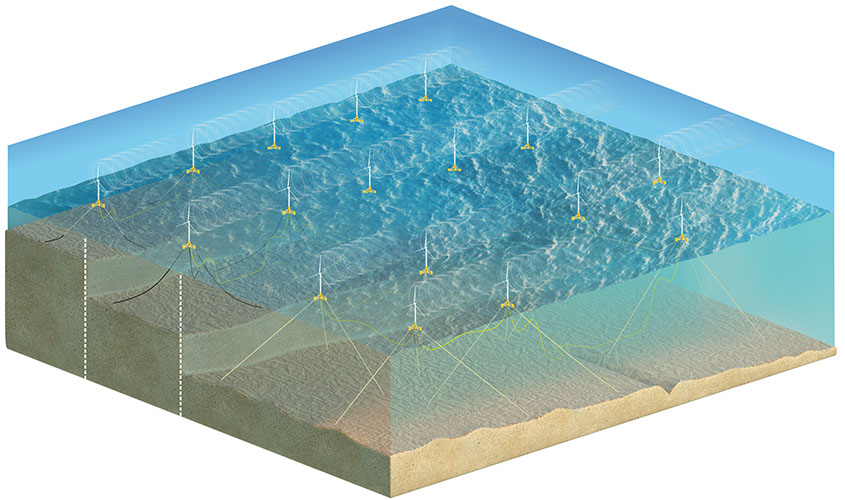Floating Array Design
NLR is developing a tool set for large-scale floating wind farm array designs and creating reference designs for several U.S. regions.

Large arrays of floating offshore wind turbines pose an unprecedented engineering challenge. To minimize the cost of energy and optimize a wind power plant, many interrelated parts of the design need to be considered simultaneously: the individual turbines, the array layout, the mooring lines and anchors, and the subsea power cables. These design aspects—along with their performance, cost, logistical, and reliability implications—need to be considered at the array scale. The impacts of the power plant on the environment and other ocean users are also key factors. Addressing all these considerations holistically calls for new design tools and methods.
This 3-year, $3 million effort by NLR to develops an integrated design tool set to systematically design all parts of a floating offshore wind farm array for given site conditions. The tool set will:
- Build on existing NLR engineering tools that are open source and widely used
- Fill key gaps in analysis capabilities for floating systems
- Integrate these tools in a holistic framework that addresses the unique challenges of floating arrays.
The project will also apply the tool set to develop several reference designs for U.S. conditions. These designs can then be used as baselines for follow-on research and development activities at the array scale.
In addition to developing reference designs, the project will contribute to the International Energy Agency Wind Technology Collaboration Programme (IEA Wind) Task 49, the Integrated Design of Floating Wind Arrays research collaboration. NLR co-leads IEA Wind Task 49 research collaboration to optimize a globally relevant set of reference designs.
The project is funded by the U.S. Department of Energy Wind Energy Technologies Office.
Objectives
In this project, NLR researchers will:
- Add realistic seabed, anchor, and dynamic power cable models to NLR design tools
- Integrate new and existing models into a streamlined, multidisciplinary analysis capability, including modeling failures at the array scale
- Create a holistic optimization framework for coupled design of array layout, mooring systems, and power cabling under realistic site-specific conditions
- Develop reference designs for different geographic regions in the United States, which will be part of the United States contribution to IEA Wind Task 49.
Tasks
The project has three parallel tasks.
Task 1: Developing and Validating New Models
Current open-source modeling tools for floating wind arrays do not account for seabed characteristics, anchor strength, and dynamic power cables. This task will fill these gaps. NLR will create a model that represents seabed soil characteristics and the strength of different anchor technologies as a function of those characteristics. NLR will also introduce capabilities for evaluation of seabed characteristics and dynamic power cables to MoorPy, a computationally efficient mooring system design tool developed by NLR. These additions will allow users to model a broader set of design drivers for floating wind farm arrays.
Working with university partners, NLR will also run wave basin experiments to create an open data set for validating the modeling capabilities.
Task 2: Creating an Integrated Analysis Capability
Design and optimization requires engineers to model all design-driving considerations, including power production, dynamic response to metocean conditions, and cost, reliability, and siting factors. FAST.Farm is a capable midfidelity engineering modeling tool for floating wind farms, but an orders-of-magnitude-faster tool is needed to efficiently explore array designs. This task builds on existing capabilities to create a tool that integrates with cost, logistics, and other models—such as for estimating impacts on the environment or other ocean users—to enable rapid evaluation of designs.
Task 3: Developing and Applying Floating System Design Methods
Turbine motions and mooring and cabling requirements create spacing constraints and a strong dependence on local seabed conditions. These complexities call for an approach to optimize over the multiple scales and inherent discontinuities. Task 3 will develop an optimization framework, which will be incrementally applied to create a set of reference floating wind farm array designs to serve as baselines for follow-on floating research. These efforts will contribute to IEA Wind Task 49.
Outputs
The project, which ran August 2022–September 2025, produced:
- An open-source software tool for multidisciplinary modeling with examples and documentation
- An open-source software tool set for design optimization with examples and documentation
- An open repository of reference designs for U.S. site conditions.
Contact
Share
Last Updated Dec. 6, 2025
